人教版(2019)选择性必修 第三册Unit 1 Art Assessing Your Progress & Project课件(22张)
文档属性
| 名称 | 人教版(2019)选择性必修 第三册Unit 1 Art Assessing Your Progress & Project课件(22张) |
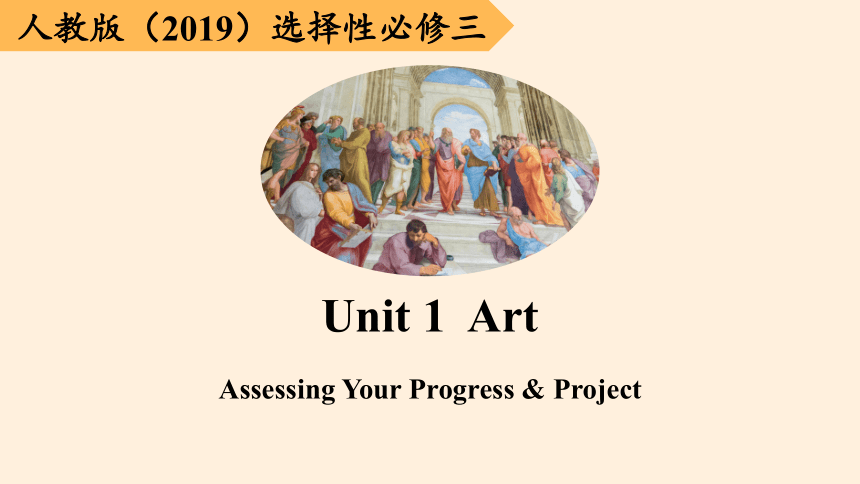
|
|
| 格式 | pptx | ||
| 文件大小 | 48.4MB | ||
| 资源类型 | 教案 | ||
| 版本资源 | 人教版(2019) | ||
| 科目 | 英语 | ||
| 更新时间 | 2023-08-16 15:11:51 | ||
图片预览


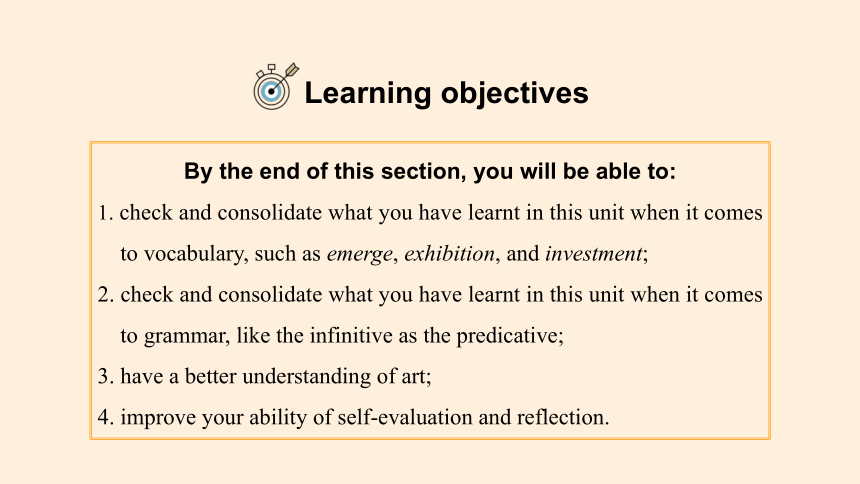
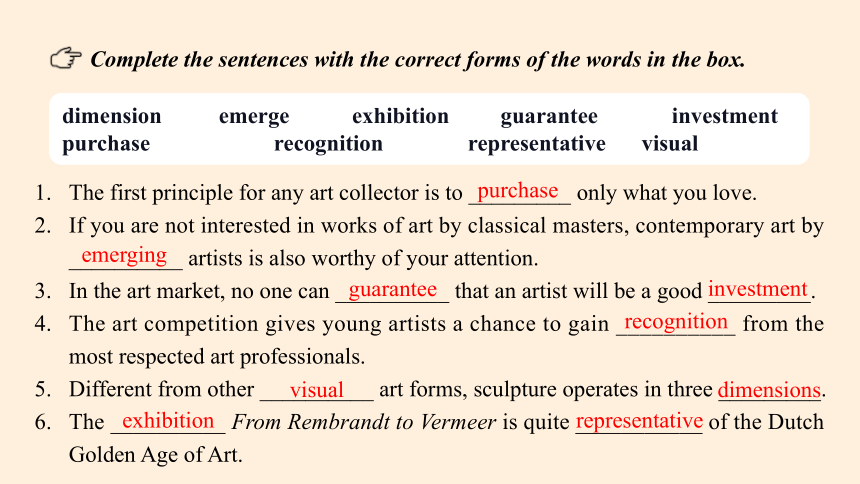
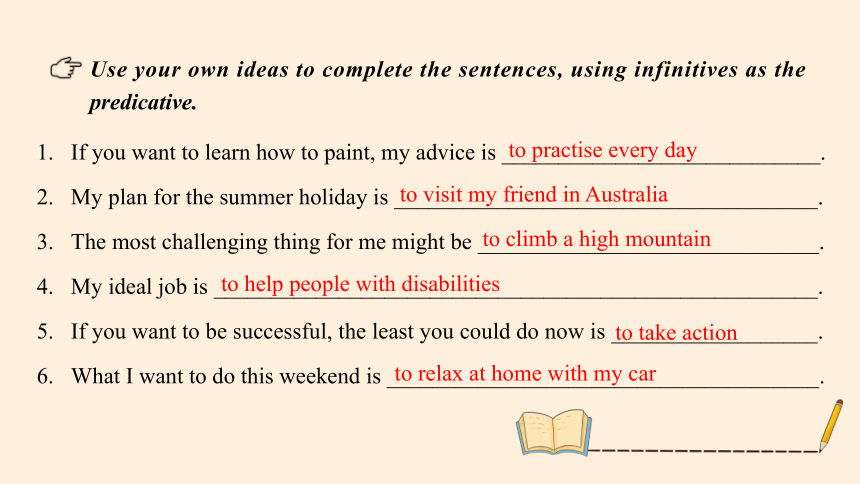
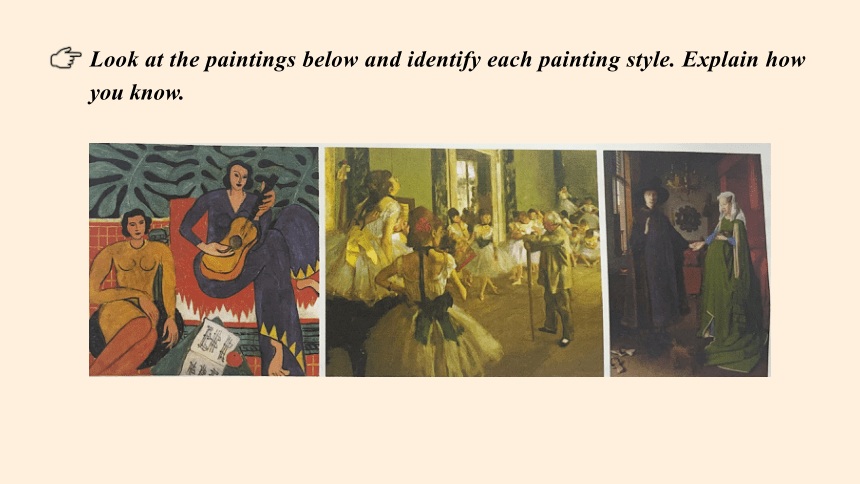
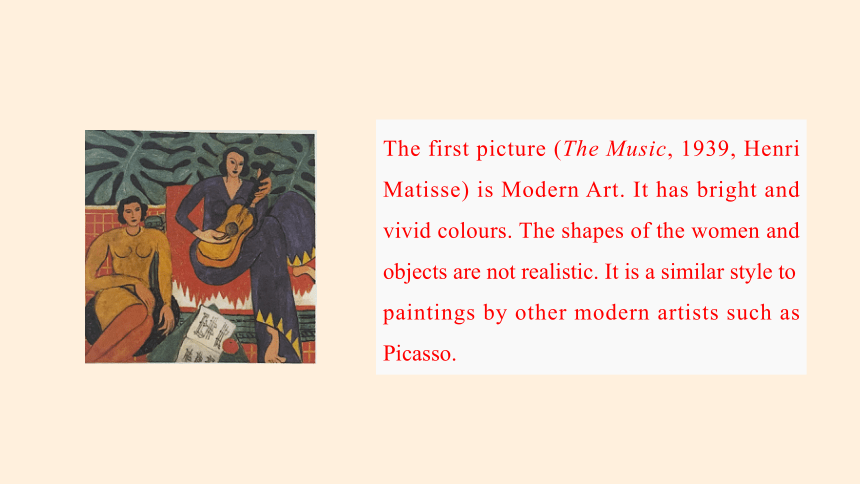
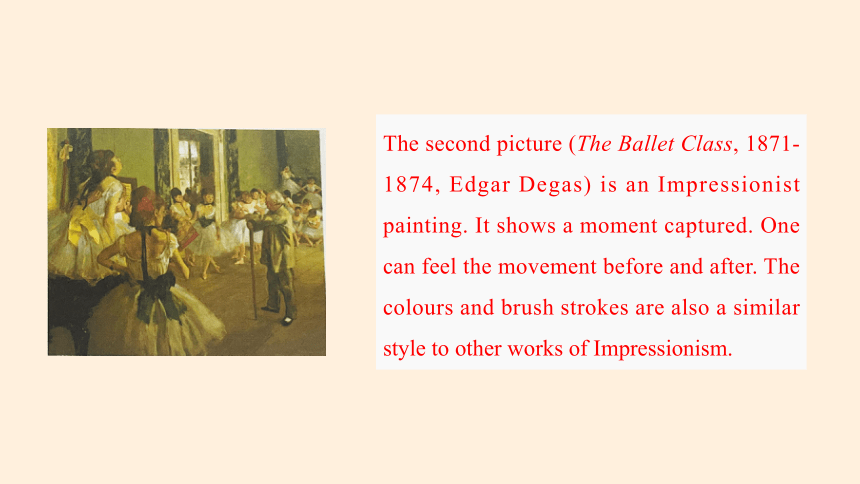
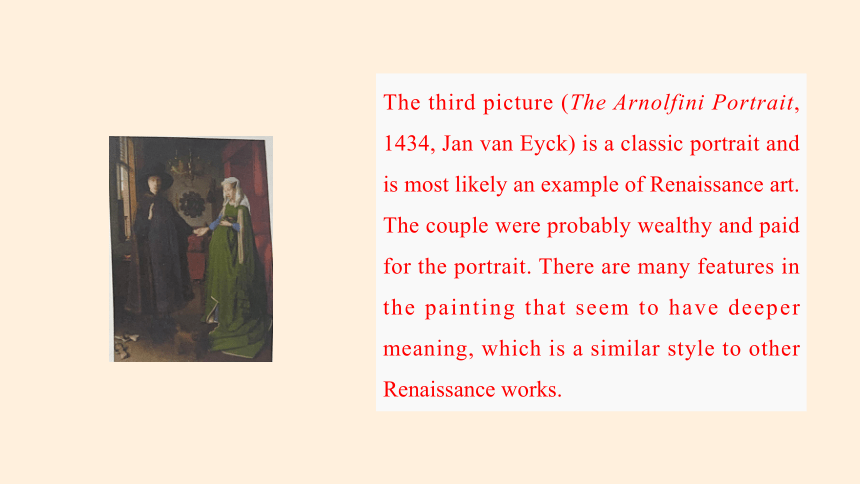
文档简介
(共22张PPT)
人教版(2019)选择性必修三
Unit 1 Art
Assessing Your Progress & Project
Assessing Your Progress
Learning objectives
By the end of this section, you will be able to:
1. check and consolidate what you have learnt in this unit when it comes
to vocabulary, such as emerge, exhibition, and investment;
2. check and consolidate what you have learnt in this unit when it comes
to grammar, like the infinitive as the predicative;
3. have a better understanding of art;
4. improve your ability of self-evaluation and reflection.
Complete the sentences with the correct forms of the words in the box.
dimension emerge exhibition guarantee investment
purchase recognition representative visual
The first principle for any art collector is to _________ only what you love.
If you are not interested in works of art by classical masters, contemporary art by __________ artists is also worthy of your attention.
In the art market, no one can __________ that an artist will be a good _________.
The art competition gives young artists a chance to gain __________ from the most respected art professionals.
Different from other __________ art forms, sculpture operates in three _________.
The __________ From Rembrandt to Vermeer is quite ___________ of the Dutch Golden Age of Art.
purchase
emerging
investment
guarantee
visual
recognition
dimensions
exhibition
representative
Use your own ideas to complete the sentences, using infinitives as the predicative.
If you want to learn how to paint, my advice is ____________________________.
My plan for the summer holiday is _____________________________________.
The most challenging thing for me might be ______________________________.
My ideal job is _____________________________________________________.
If you want to be successful, the least you could do now is __________________.
What I want to do this weekend is ______________________________________.
to practise every day
to visit my friend in Australia
to climb a high mountain
to help people with disabilities
to take action
to relax at home with my car
Look at the paintings below and identify each painting style. Explain how you know.
The first picture (The Music, 1939, Henri Matisse) is Modern Art. It has bright and vivid colours. The shapes of the women and objects are not realistic. It is a similar style to paintings by other modern artists such as Picasso.
The second picture (The Ballet Class, 1871-1874, Edgar Degas) is an Impressionist painting. It shows a moment captured. One can feel the movement before and after. The colours and brush strokes are also a similar style to other works of Impressionism.
The third picture (The Arnolfini Portrait, 1434, Jan van Eyck) is a classic portrait and is most likely an example of Renaissance art. The couple were probably wealthy and paid for the portrait. There are many features in the painting that seem to have deeper meaning, which is a similar style to other Renaissance works.
REFLECTING
What new information concerning art have you learnt from this unit
Which artist mentioned in the unit do you like most Why
Which art style would you like to learn more about Why
Which part of this unit did you find the most difficult How did you overcome it
Overall, I thought this unit was interesting useful so-so difficult.
Workbook
-ism: ________________________________________________________________________________
-istic: _______________________________________________________________________________
-ity: ________________________________________________________________________________
-(t)ion: ______________________________________________________________________________
______________________________________________________________________________
-ist: ________________________________________________________________________________
-ive: ________________________________________________________________________________
List the words with the following suffixes and explain the use of each suffix. Use a dictionary if necessary.
Impressionism, Cubism, Buddhism
Used to form nouns meaning a teaching, system, or movement
humanistic, artistic
Used to form adjectives meaning being of or connected to something
reality, stupidity, curiosity
Used to form nouns denoting a quality or state
reputation, intention, exhibition, recognition, innovation, invention, punctuation, presentation, explanation, description, introduction, education, suggestion, animation, collection, attention, competition, information
Used to form nouns denoting an action or state
realist, artist, Impressionist
Used to form nouns denoting a person who believes, practises, does, or uses something
primitive, subjective, perspective, representative, creative
Used to form nouns and adjectives denoting having the nature of something
realism
realistic
Think of a word that best fits each definition and complete the puzzle.
Down:
a decrease in number, value, quality, etc.
a small area of still water
a statue, or a stone that reminds people of a past event or a person who has died
long piece of music written for an orchestra
to express your disapproval of someone or something
Across:
the increase of something in size, number, amount, etc.
believing you are less important than others
belonging to the present time
connected with ordinary people in a country
a container used to keep flowers
expansion
humble
contemporary
civil
vase
decline
pond
memorial
symphony
criticise
Translate these sentences into English, using the words and phrases in brackets.
1. 他优雅的举止和英俊的面容使他与其他来宾截然不同。(set ... apart from)
2. 在当代所有女作家中,我认为她是最值得尊重的一位。(contemporary, be worthy of)
3. 近些年来,医学工作者在癌症研究方面获得了突破。(make/achieve a breakthrough)
4. 在我看过的所有印象派画作当中,我尤其喜欢雷诺阿的作品。(in particular)
5. 电影《敦刻尔克》(Dunkirk) 把二战中的一次重要事件进行了真实的再现。(bring ... to life)
His elegant behaviour and handsome face set himself apart from other guests.
I think that she is worthy of the greatest respect among all contemporary female writers.
In recent years, medical workers have made/achieved a breakthrough in cancer research.
Among all Impressionist paintings I have seen, I like Renoir’s works in particular.
The film Dunkirk brings an important event in World War II to life.
Project
Do a talk show about an artist
Learning objectives
By the end of this section, you will be able to:
1. learn how to do a talk show;
2. use knowledge you have learnt to do a talk show;
3. improve your ability of performing during role-play.
Preparation
In groups, brainstorm a list of famous artists and their representative works. Here are some ideas.
Decide on which artist your group is going to talk about.
Choose one person to be the talk show host, one person to be the artist, and the remaining members to be a family member, a friend, a teacher, or an art critic. Have each person do research on the artist and prepare notes on what he/she will say.
Do a talk show
talk show host: questions for the guests
artist: biography of the artist, philosophy towards art, details about his/her most representative works
family: What was the artist like when he/she was a child or growing up What was it like living with the artist What do they think of the artist’s talent and work
friend: How did they meet the artist What is the artist like as a person What do they think of the artist and his work
teacher: What was the artist like as a student Could he/she imagine that the artist would grow up to be famous
art critic: How is the artist’s work critically received
Now role-play your talk show before your class.
Notes for doing the talk show:
Keep in mind that guests may have different opinions as to what the artist is like and how talented he/she was, so they should feel free to disagree and discuss.
If possible, the group should also find large photos or posters of the artist’s representative work to be used as talk show exhibits.
Towards the end of the talk show, the host should go out into the “audience” (i.e., the class) and take questions from the audience.
SHOW TIME
Review what your have learned in this unit.
According to the teacher’s and classmates’ evaluation, polish up your talk show.
Homework
人教版(2019)选择性必修三
Unit 1 Art
Assessing Your Progress & Project
Assessing Your Progress
Learning objectives
By the end of this section, you will be able to:
1. check and consolidate what you have learnt in this unit when it comes
to vocabulary, such as emerge, exhibition, and investment;
2. check and consolidate what you have learnt in this unit when it comes
to grammar, like the infinitive as the predicative;
3. have a better understanding of art;
4. improve your ability of self-evaluation and reflection.
Complete the sentences with the correct forms of the words in the box.
dimension emerge exhibition guarantee investment
purchase recognition representative visual
The first principle for any art collector is to _________ only what you love.
If you are not interested in works of art by classical masters, contemporary art by __________ artists is also worthy of your attention.
In the art market, no one can __________ that an artist will be a good _________.
The art competition gives young artists a chance to gain __________ from the most respected art professionals.
Different from other __________ art forms, sculpture operates in three _________.
The __________ From Rembrandt to Vermeer is quite ___________ of the Dutch Golden Age of Art.
purchase
emerging
investment
guarantee
visual
recognition
dimensions
exhibition
representative
Use your own ideas to complete the sentences, using infinitives as the predicative.
If you want to learn how to paint, my advice is ____________________________.
My plan for the summer holiday is _____________________________________.
The most challenging thing for me might be ______________________________.
My ideal job is _____________________________________________________.
If you want to be successful, the least you could do now is __________________.
What I want to do this weekend is ______________________________________.
to practise every day
to visit my friend in Australia
to climb a high mountain
to help people with disabilities
to take action
to relax at home with my car
Look at the paintings below and identify each painting style. Explain how you know.
The first picture (The Music, 1939, Henri Matisse) is Modern Art. It has bright and vivid colours. The shapes of the women and objects are not realistic. It is a similar style to paintings by other modern artists such as Picasso.
The second picture (The Ballet Class, 1871-1874, Edgar Degas) is an Impressionist painting. It shows a moment captured. One can feel the movement before and after. The colours and brush strokes are also a similar style to other works of Impressionism.
The third picture (The Arnolfini Portrait, 1434, Jan van Eyck) is a classic portrait and is most likely an example of Renaissance art. The couple were probably wealthy and paid for the portrait. There are many features in the painting that seem to have deeper meaning, which is a similar style to other Renaissance works.
REFLECTING
What new information concerning art have you learnt from this unit
Which artist mentioned in the unit do you like most Why
Which art style would you like to learn more about Why
Which part of this unit did you find the most difficult How did you overcome it
Overall, I thought this unit was interesting useful so-so difficult.
Workbook
-ism: ________________________________________________________________________________
-istic: _______________________________________________________________________________
-ity: ________________________________________________________________________________
-(t)ion: ______________________________________________________________________________
______________________________________________________________________________
-ist: ________________________________________________________________________________
-ive: ________________________________________________________________________________
List the words with the following suffixes and explain the use of each suffix. Use a dictionary if necessary.
Impressionism, Cubism, Buddhism
Used to form nouns meaning a teaching, system, or movement
humanistic, artistic
Used to form adjectives meaning being of or connected to something
reality, stupidity, curiosity
Used to form nouns denoting a quality or state
reputation, intention, exhibition, recognition, innovation, invention, punctuation, presentation, explanation, description, introduction, education, suggestion, animation, collection, attention, competition, information
Used to form nouns denoting an action or state
realist, artist, Impressionist
Used to form nouns denoting a person who believes, practises, does, or uses something
primitive, subjective, perspective, representative, creative
Used to form nouns and adjectives denoting having the nature of something
realism
realistic
Think of a word that best fits each definition and complete the puzzle.
Down:
a decrease in number, value, quality, etc.
a small area of still water
a statue, or a stone that reminds people of a past event or a person who has died
long piece of music written for an orchestra
to express your disapproval of someone or something
Across:
the increase of something in size, number, amount, etc.
believing you are less important than others
belonging to the present time
connected with ordinary people in a country
a container used to keep flowers
expansion
humble
contemporary
civil
vase
decline
pond
memorial
symphony
criticise
Translate these sentences into English, using the words and phrases in brackets.
1. 他优雅的举止和英俊的面容使他与其他来宾截然不同。(set ... apart from)
2. 在当代所有女作家中,我认为她是最值得尊重的一位。(contemporary, be worthy of)
3. 近些年来,医学工作者在癌症研究方面获得了突破。(make/achieve a breakthrough)
4. 在我看过的所有印象派画作当中,我尤其喜欢雷诺阿的作品。(in particular)
5. 电影《敦刻尔克》(Dunkirk) 把二战中的一次重要事件进行了真实的再现。(bring ... to life)
His elegant behaviour and handsome face set himself apart from other guests.
I think that she is worthy of the greatest respect among all contemporary female writers.
In recent years, medical workers have made/achieved a breakthrough in cancer research.
Among all Impressionist paintings I have seen, I like Renoir’s works in particular.
The film Dunkirk brings an important event in World War II to life.
Project
Do a talk show about an artist
Learning objectives
By the end of this section, you will be able to:
1. learn how to do a talk show;
2. use knowledge you have learnt to do a talk show;
3. improve your ability of performing during role-play.
Preparation
In groups, brainstorm a list of famous artists and their representative works. Here are some ideas.
Decide on which artist your group is going to talk about.
Choose one person to be the talk show host, one person to be the artist, and the remaining members to be a family member, a friend, a teacher, or an art critic. Have each person do research on the artist and prepare notes on what he/she will say.
Do a talk show
talk show host: questions for the guests
artist: biography of the artist, philosophy towards art, details about his/her most representative works
family: What was the artist like when he/she was a child or growing up What was it like living with the artist What do they think of the artist’s talent and work
friend: How did they meet the artist What is the artist like as a person What do they think of the artist and his work
teacher: What was the artist like as a student Could he/she imagine that the artist would grow up to be famous
art critic: How is the artist’s work critically received
Now role-play your talk show before your class.
Notes for doing the talk show:
Keep in mind that guests may have different opinions as to what the artist is like and how talented he/she was, so they should feel free to disagree and discuss.
If possible, the group should also find large photos or posters of the artist’s representative work to be used as talk show exhibits.
Towards the end of the talk show, the host should go out into the “audience” (i.e., the class) and take questions from the audience.
SHOW TIME
Review what your have learned in this unit.
According to the teacher’s and classmates’ evaluation, polish up your talk show.
Homework
